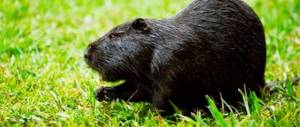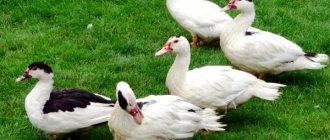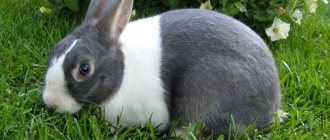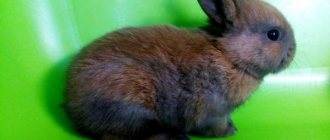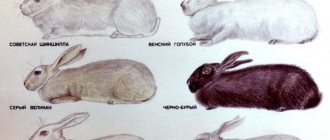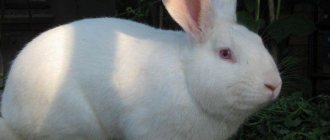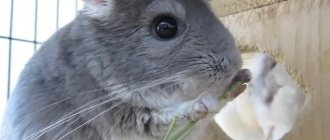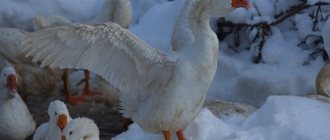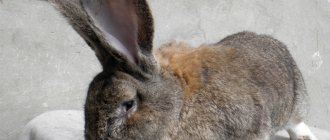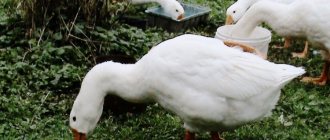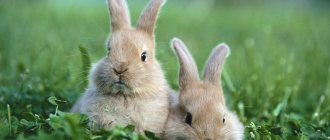0
1529
Article rating
Hicole broiler rabbits do not actually belong to the breed line, because they do not have hereditarily fixed productivity. They are meat hybrids with a very high rate of weight gain.
Origing 300w, https://pro100ogorod.ru/wp-content/uploads/2018/10/shutterstock_0-36-90×68.jpg 90w" sizes="(max-width: 600px) 100vw, 600px" /> Description of rabbits Hicol breed
Description of Hikol rabbits
Hicol rabbits are a hybrid breed that was obtained from a French breeding line.
The main advantage is high rates of weight gain. These rabbits are bred to produce meat products with excellent taste. Another feature is the difficulty of breeding naturally. The hybrid breed requires artificial insemination, which only pays off on large farms.
Reference. The average representative of the Hikol breed produces up to 60% meat in the total weight of the animal. Young Hikol animals “eat” up to 50 grams of weight gain per day.
Description and characteristics
The Hikol breed is characterized by light fur color: white, beige, gray. Also, representatives of this hybrid can have a colorpoint color, when the nose and ears of the animal are painted a darker color than the rest of the body. The breed standard describes a body length of 50 to 54 cm, a short neck, a compact head with an elongated nose. The animal's back is wide and straight, and its hindquarters are massive.
Other standard breed characteristics:
- wide set of eyes, the eyes themselves are red, with a light rim;
- low-set abdomen;
- short, widely spaced front legs;
- straight tail with shading;
- short ears up to 11 cm long, spoon-shaped.
Advantages of the breed
The Hicol hybrid is the most popular meat breed for farm breeding due to a number of advantages: rapid weight gain, high meat yield, and no problems in growing and caring for. This broiler breed allows you to get 4.5-5 kg of live weight when the young animals reach 4 months of age. Rabbits of this breed have light bones and no predisposition to obesity.
Reference. France is engaged in breeding breeding stock of the Hicol breed. It is a monopolist and has branches selling breeding animals all over the world.
Additional advantages of the breed are high fertility. 10-12 babies appear in one litter. During industrial rearing, females give up to 10 litters per year, after which they are removed from the breeding stock.
The advantage of the breed is high fertility
Content
Hikol rabbits are allowed to use cages with mesh floors. Due to the good hairiness of the paws, this design will not harm the health of the animal and will greatly simplify the cleaning of rabbit habitats. The rabbitry is located in places protected from drafts and direct sunlight. Keeping temperature is not lower than 16-17°C, including in the cold season.
Males of the Hikol breed are kept alone, and females - 2-3 individuals in one cage. Animals are provided with ventilation, balanced feeding, and access to fresh water. It is recommended to wash and refill drinking bowls every 12 hours.
Vaccinations
Rabbits definitely need vaccinations. These animals are susceptible to infections such as myxomatosis and hemorrhagic disease. They cannot be treated and the rabbits die as a result. This is why young animals need vaccinations.
It is best to vaccinate at 7 weeks of age. During this period, rabbits tolerate it most easily. Immunity to pathogens lasts for 6-9 weeks. As a rule, there is no need for revaccination, because After this age, animals lose their reproductive function and are sent to slaughter.
After vaccination, the individual must be isolated from others for 2 weeks. This is due to the fact that it is during this period that immunity to pathogenic microorganisms is developed. If you place a vaccinated rabbit with others, it may become infected, which means vaccination will be useless.
Feeding
Broilers of the Hikol breed are distinguished by their undemanding food requirements. They easily adapt to various types of food: they eat hay, fresh and boiled vegetables, corn, barley. A prerequisite for high-quality weight gain is feeding rabbits with granulated feed. Their high cost is compensated by a large yield of meat, which is especially beneficial for large farms.
Hicol rabbits need to make hay. The optimal period for this is June and July, when the grass has the maximum amount of protein and high nutritional value. Legumes must be included in the animal’s diet, due to which they partially reduce the amount of granulated feed and reduce the cost of cultivation. A kilogram of green legumes contains about 25 grams of protein, which is perfectly digestible by rabbits.
Making hay for Hikol rabbits
When raising Hikol rabbits, there must be food in the feeders at all times. Therefore, bunker structures are used to supply feed. The number of meals these animals eat can reach 50 per day, which contributes to rapid weight gain.
Breeding Hikol rabbits is economically profitable. That is why this broiler hybrid is common in industrial rabbit breeding. It is recommended to buy animals for raising or breeding only in specialized nurseries, at exhibitions or at representative offices.
How to choose a rabbit
Any potential buyer wants to make the right choice and not make a mistake. In this case, this is not easy to do, because if you compare the photo of Hiplus and his parent, the breed of which is completely different in parameters, it is not easy to distinguish them. The hybrid does not have a clearly defined color. Pets can be white, white with black or gray spots, gray, black. As mentioned earlier, documentary proof of breed membership is required.
When choosing, it is advisable to pay attention to the behavior of the young animals. Animals must be active and have a good appetite. If the little rabbit is lethargic, sleepy, sits still more than plays, does not want to eat, or does it in very limited quantities, you should not buy it. If an animal has receding hairline, watery eyes, or strange discharge from the ears, mouth or nasal cavity, one has to conclude that the rabbit is sick. If you notice any defects, you need to inform the owner of the farm about it; perhaps he himself does not know about it.
It is recommended that any buyer purchase an animal in consultation with a veterinarian. A specialist can conduct an inspection before purchasing, and he will accurately determine whether the rabbit is healthy, because there are problems that are difficult for a non-professional to notice.
The price of Hiplus is at least 20 euros per piece in the homeland of the cross, and if you count exports and customs duties, the cost in our country may differ significantly. The direct purpose of the hybrid is meat. You need to get an animal for this purpose. At the same time, you should calculate the financial costs of feeding and maintenance in advance, so that later this does not turn out to be an unpleasant surprise. Complying with sanitary standards, proper care, and timely examinations by a veterinarian is the key to a successful result. These efforts will more than pay off when selling Hiplus carcasses.
Hycole breed standards
Rabbits of the Hikol breed are light in color, but do not have a standard fur color.
There are individuals of white, gray, cream color, as well as colorpoint (the body is white, the nose and ears are dark colored). Breed standard:
- ears are spoon-shaped, short - up to 10-11 cm;
- the head is small and light;
- the nose is extended;
- the eyes are set wide apart, red with a light edging in the sclera;
- the neck is short;
- body length reaches 50-54 cm;
- the back is straight, wide;
- the stomach is low;
- the croup is very massive;
- the front legs are quite short, widely set;
- the hind legs are powerful, positioned correctly when viewed from behind;
- the tail is straight with a dark edging.
The Hikol breed is a meat breed and is raised as a broiler breed for cage keeping and compound feeding. Providing a proper and balanced diet allows you to achieve an increase in body weight of 45-60 grams daily. A weight of 3.5 kg sufficient for slaughter is achieved within 3-4 months, which is a record figure among meat breeds of rabbits.
Breeding
To obtain maximum meat productivity, rabbits are purchased from nurseries and fattened. Sometimes farmers purchase California and New Zealand rabbits and cross them.
In large rabbit breeding farms, they follow the most correct path: they acquire the progenitors of the cross, get parents from them, and then breed the target rabbits from them. When breeding hipluses, the principle of compacted litters is used. A litter produces more than 10 rabbits. Females are fertilized artificially after 18 days. They are placed in another cage from the rabbits on the 35th day. A breeding male is kept with 20 females.
The young animals are subsequently housed in groups of 7. Ready for sale in 78 days. After 10-11 months the female is replaced. Natural insemination is not recommended, as there is a high probability of false pregnancy.
It is profitable to breed Hipluses. From one female of reproductive age, with a tight litter schedule, 60 rabbits are produced within 300 days. The young animals reach a weight of 5 kg by the age of three months. Costs for maintenance and fattening are lower than for other breeds.
Hiplus is a hybrid; there is no point in breeding the cubs born by them. The genes responsible for special “meat” qualities will be lost. Vitality will also be lost.
Features of reproduction
The Hikol rabbit is a hybrid breed, which means that members of the breed cannot reproduce naturally due to their hybrid origin. Females are artificially inseminated, respecting their genetic line and affiliation to produce offspring with a full list of breed characteristics. Crossing representatives of the Hikol breed in a natural way does not allow obtaining full-fledged offspring and leads to loss of qualities already in the first generation.
Because of this breeding feature, it is not profitable to breed rabbits in private households and small farms. Artificial insemination requires material costs and only pays off on large farms.
PS females are highly fertile. On average, a female gives birth to 10-12 cubs per litter, often up to 15-16. Thanks to the ability of a female to quickly recover, one female can produce 7.4-8.6 litters per year, however, in this mode, the females quickly “wear out” and are removed from breeding when their performance drops. To maintain the productivity of the herd, the breeding stock requires renewal at the level of 10-20% every year.
Rabbit Hikol has 10 nipples, thanks to which she is able to provide all her rabbits with milk equally. At the same time, it is important to provide the female with a balanced diet during pregnancy and feeding the offspring, for which lactating food and “ad libitum feeding” are used.
Rabbits of the Hikol and Hiplus breeds: characteristics and breeding
These complex hybrids owe their appearance to the development of industrial rabbit breeding for meat production.
The basis was taken from such well-known meat rabbit breeds as New Zealand White and Californian. Genetics had a hand in their creation. With their help, the genome of the parent breeds was artificially supplemented with a new set of genes. These rabbits are most popular in European countries, where they are raised on large rabbit farms.
Loading …
Despite the fact that these rabbits have outstanding fattening and early maturing qualities, keeping them on personal farmsteads is unprofitable from an economic point of view.
The thing is that the purpose of the genetic work was to obtain animals for broiler rearing, which requires expensive pelleted feed.
Without such a special diet, these animals are not able to reach their full potential.
In addition, Hiplus and Hikol rabbits are not suitable for natural reproduction, and artificial insemination is a rather expensive procedure.
For these two reasons, the costs of breeding and growing these hybrids pay off only with a serious volume of production.
general characteristics
I would like to begin the description of these animals with their exceptional fertility. The average number of babies in one litter is ten rabbits. Considering that the females of these hybrids can bear offspring up to nine times a year (and some individuals – 15 times), this results in a very high figure.
The second distinctive feature is the high rate of weight gain in young animals.
Hybrid cubs grow by leaps and bounds, and are able to gain 45-55 grams of weight daily. At the age of two to three months, they already weigh four kilograms and are ready to be slaughtered for meat.
The slaughter yield from one rabbit ranges from 57 to 60 percent pure meat, which, given the rapid growth of the livestock, gives an impressive amount of rabbit meat obtained.
Also, both of these varieties are distinguished by their early maturity. They reach puberty at the age of four months.
Selection and genetic work to create such rabbits has been carried out for more than 30 years.
As a result, animals were obtained with the following undeniable advantages.
The main advantages of complex hybrids:
- high fertility of rabbits (the average number of rabbits in one litter is from 10 to 12);
- homogeneity of the offspring (all cubs are similar to each other, like clones);
- reproduction time (when using the compacted litter technique - from 10 to 12 months);
- high milk production rates (one female rabbit has 10 nipples and can easily feed 10 rabbits).
Rabbits Hiplus
- high live weight, inherited;
- slaughter yield of clean rabbit meat is 57-60 percent of the animal’s weight before slaughter (considering slaughter at an early age, this is an outstanding indicator);
- ratio of growth to feed costs (per unit of gain requires less feed than the ancestors);
- good immunity to intestinal and stomach diseases.
Breeding Features
The progenitors themselves are hybrids, so it will not be possible to breed them naturally. If necessary, the breeding stock is constantly updated through French reproductive centers.
Only the great-great-parents available in this company are representatives of the “pure” line, and they are not sold outside their central nursery.
This approach, on the one hand, makes it possible to obtain animals with predetermined productive characteristics, and on the other, provides the company with a monopoly on the breeding market of these types of meat rabbits.
How to purchase these hybrids?
It should be said right away that outwardly such rabbits are no different from their ancestor breeds. There is no specific color standard. They can be white like New Zealanders or spotted like Californians. There are also gray individuals. Therefore, it is possible to prove that these are exactly the same hybrids only through documentation. And in Russia, as you know, forging any document is not a problem.
Livestock Hikol
There is only one way out - buy only from trusted sources, which are the representative offices of the above-mentioned French company, which can be contacted through the official website.
The cost of one ten-week-old female rabbit in France is 21 euros, but you can buy it at the Russian representative office, where the price of a twelve-week-old female is 23 euros, and a male is 24-25. This applies to animals raised locally, but rabbits can be sourced from France itself twice a year.
Rabbit breeding. “Living House” program
Source: //GoFerma.ru/zhivotnovodstvo/kroliki/kroliki-hikul-i-hiplus-opisanie.html
Animal keeping
To achieve the declared indicators of the Hikol breed, it is necessary to provide the following conditions for keeping the livestock:
- Ventilation and fresh air supply per kg of weight, in the absence of drafts
- Maintaining thermal conditions and humidity in the hall using an automatic microclimate control system
- Compliance with daylight hours
- Rationing of feed distribution
- Providing livestock with quality water
- Timely implementation of veterinary measures and maintenance of sanitary conditions
- Application of disinfection, disinsection and deratization systems
Feeding livestock can be done manually by distributing feed into feeders, however, automatic storage and distribution systems are recommended to significantly reduce personnel labor costs and ensure better quality rationing of feed. The structure of rabbits' paws allows them to be kept on a mesh cage floor, which simplifies the removal of manure and feces from the cage and allows the use of automated manure removal systems. To provide water around the clock, nipple drinking systems are used using filtration, water treatment and medication systems.
It is allowed to keep 2-3 females in one cage, however, during pregnancy, childbirth and milk feeding, each female must be provided with a separate cage with a birthing nest, where she stays with the young until the age of 4-5 weeks, after which the female is placed in free cages . In industrial breeding, the “empty-occupied” system is recognized as the most effective, when only one group of animals of the same age is kept in one room, and the females are deposited in an empty, prepared room. This allows you to organize an insemination and rearing cycle of 42-49 days, carry out veterinary measures for the entire hall and carry out full measures for cleaning and disinfecting the halls between plantings. Males, when they reach sexual maturity, become aggressive and require placement in individual cages isolated from each other in order to avoid fights among themselves and injury.
By purchasing Hycole stock from our Breeding Center, you receive a Technical Guide for Growing developed by specialists and can undergo training and internship in our Training Center.
Diet
Hikol rabbits have increased gastrointestinal stability and adapt well to various types of food. They willingly eat grass, hay, fresh and boiled vegetables, wheat, sunflower seeds, corn, and barley. But in order for animals to gain weight and fully justify their breed characteristics during industrial breeding, granulated concentrated feed is used.
Compared to their ancestors, Hikolys require fewer units of feed to gain body weight, this is an undeniable benefit for the farm.
Short description
Hipluses are carriers of the genes of rabbits of the New Zealand, Californian and Belgian breeds.
They belong to the meat variety. They have strong short legs, an elongated body, small ears, a small neck and a medium-sized head. The fur is thick. Eyes pink, red or brown.
This is where the external description of the breed can be completed, since the hiplus has no individual color characteristics. There are white, gray and black, spotted rabbits.
Proof that a hiplus has been acquired can only be accompanying documents from the nursery and the most important properties exhibited during the process of raising the animal, which is why rabbit farms are so eager to acquire them:
- heavy weight (on average 5 kg at 3 months);
- high feed yield;
- rapid growth (50–55 grams per day);
- high resistance to gastrointestinal diseases;
- multiple births (10–12 rabbits);
- good milk production of females (easily feeds 10 rabbits).
The listed advantages also include a healthy meat yield of 60%.
Literally from French, Chi Plus means “adding.” In this situation, improved qualities were added to the predecessor breeds.
How to buy Hicol rabbits
Due to the lack of obvious signs of the breed, it is difficult to determine whether it belongs to the Hikol breed by external signs. Australian or California white rabbits are often passed off as Hickoli. In Russia, only our Breeding Center officially grows the Hycole breed for sale, so you should not purchase animals based on advertisements on the Internet, markets or dubious farmsteads. In any case, please note that each male and female breeder must have a unique ear tattoo and accompanying documents by which you can verify their authenticity.
You can purchase HYCOLE rabbits directly from the manufacturer in France, but delivery will be much more expensive compared to our center in Russia and you will not be able to buy small batches of 100 - 200 animals in France for restocking.
You should also be careful when choosing an animal. A rabbit that is overly calm and lethargic is most likely sick with something. Bald spots on the fur, at best, indicate poor living conditions and poor nutrition; at worst, these can be symptoms of contagious diseases. In our center, all animals supplied for sale are hand-selected, have all the necessary vaccinations and accompanying documents, and are quarantined under veterinary supervision, which eliminates the supply of sick and low-quality animals.
For industrial breeding, on small farms with up to 500 females, as a rule, only PS parent females are purchased. For artificial insemination, male seed material supplied by the Breeding Center in the form of sperm doses is used. Resumption of wear of breeding stock is carried out by purchasing the required quantity. For small farms, this option is the most profitable, because... The quality of livestock and seed material is constantly guaranteed by the Breeding Center.
Selection and purchase of Hikol rabbits
Since the breed is distinguished by a number of specific features, in particular in terms of reproduction, rabbits can only be purchased from specialized farms and only if the buyer is aware of the difficulties of future breeding. Hikol rabbits are purchased by specialized farms with industrial production volumes. They purchase young animals from companies that engage in such complex breeding.
Rabbits must have appropriate passports confirming their origin and health. Externally, the inspection is the same as when purchasing other rabbits:
- Clean, tangle-free wool.
- Clear eyes.
- No discharge.
- Cheerful behavior.
- Stable appetite.
In the Russian Federation, a specialized breeding specialist is engaged in breeding purebred rabbits. Here you can purchase breeding animals with a tattoo on the ear, guaranteeing the purity of the breed and belonging to different breeding lines to avoid closely related origins. This broiler-type breed gives a rapid increase in dietary meat, but is not suitable for household use and is suitable for mass, industrial breeding.
Description and features of the hybrid
The Hikol breed is valued for its rapid weight gain, so the main purpose of breeding these rabbits is to produce excellent quality dietary meat. Eared young animals gain up to 50 g of weight per day. The usual meat yield at slaughter is slightly more than half the total weight of the rabbit.
When breeding this breed, the livestock breeder must be prepared for problems with natural reproduction. To maintain the purity of the hybrid line, it is necessary to use only artificial insemination, which requires serious costs, so it is most profitable to breed these rabbits in large farms.
Breeding history
Hicol rabbits are a hybrid obtained as a result of breeding work by French biologists. To this day, the French retain a monopoly on the breeding of this breed. The company has branches selling these animals in various countries around the world.
Standard
The fur coat of Hicol rabbits is colored in light colors: usually white, gray and beige. Colorpoint fur also happens: this is when the fur on the ears and nose has a darker color than the entire fur coat.
Breed standard:
- body length 50–54 cm;
- body weight 4.5–5 kg;
- a small head sits on a short neck;
- nose slightly elongated;
- the back is wide and flat;
- the back of the body is much larger than the front;
- eye color - red with a light rim;
- eyes set wide apart;
- the stomach is low;
- the front legs are short and widely spaced;
- the tail is short and straight, pressed tightly to the body;
- The ears are short (up to 11 cm), pubescent on one side.
Advantages and disadvantages
Hikol is a very popular broiler breed among rabbit breeders, as it has obvious advantages:
- rapid weight gain;
- excellent meat yield after slaughter (60% of total body weight);
- low maintenance requirements.
Broiler rabbits reach a body weight of 4.5–5 kg (live weight) by 4 months of age; representatives of the breed are not prone to fat deposition. One of the advantages of the breed is the good fertility of females. Each can bring 10 or 12 babies in one litter. In industrial rabbit breeding, a female Hikol bears up to 10 offspring per year, after which it becomes unsuitable for breeding.
The only disadvantage of the breed is the impossibility of natural reproduction without loss of hybrid qualities. Purity of the breed line can only be achieved through artificial insemination. When crossing males and females of the Hicol breed, the purity of the breed is lost after 2–3 generations.
A little historical background
So, Hiplus and Hicol rabbits are meat hybrids. Their ancestors were the best representatives of the Californian and New Zealand white breeds. Often the name “hiplus” is pronounced more softly “hiplus”. And this is also true, it all depends on how one reads the French Hy-Plus.
Read also: Rabbits bleed: reasons, what to do
Breeders working to create a new breed took only the best characteristics of meat giants as a basis and added fresh genes to them. Thanks to this, new breed lines have unique qualities.
The work took more than 10 years. Many characteristics have improved, including reproductive function. The number of rabbits in one litter was increased from 8 to 10-12. Hybrid cubs grow literally by the hour, adding 50-55 g per day.
As a result, rabbits of the Hiplus or Hicol breeds at the age of 3 months already reach a body weight of 4 kg and are ready for slaughter. Slaughter yield is about 60%.
The Hicol and Hiplus breeds are especially popular among large European breeders. The fact is that growing these lines at home is completely unprofitable. This is explained by the need to feed animals with special feed, the cost of which cannot be called low.
Another factor is the characteristics of reproduction. To obtain purebred individuals, the natural method of conception is not suitable. And artificial insemination is one of the most expensive procedures. The combination of these reasons makes the cultivation of meat hybrids profitable only when it comes to large production scales.
Maintenance and care
To get good results, the rabbit breeder needs to provide the most favorable conditions for keeping furry pets: spacious and warm cages, dry bedding, well-balanced nutrition. It is important not to forget about timely vaccination, because these animals are easily infected with viral diseases.
Selection and arrangement of the cage
When keeping rabbits of this breed in cages, the following requirements must be taken into account:
- Hikol rabbits are kept in cages with slatted bottoms. Since the animal's paws are well furred, the slatted floor will not harm them. The bottom in the form of a mesh or lattice will make cleaning the cage easier, as it freely allows rabbit waste to pass through. Cages are made of wood or metal, the latter is preferable, since rodents render the wooden parts of the cage unusable after a couple of years.
- The bottom is covered with dry straw, which is replaced with fresh straw 2-3 times a week. You can also use sawdust from non-resinous trees as bedding. The litter must be hygroscopic and warm.
- Rabbit cages can be placed in several tiers - one above the other. At the same time, you need to remember that the lower cages should never be placed on the ground or floor of the rabbitry; there must be legs or trestles under them (at least 40–50 cm high). This is necessary to create an air gap between the cold air near the floor and the bottom of the cage.
- Size of cages for female rabbits with a litter: house length from 175 to 185 cm, width - up to 1 m, height - 55–70 cm. Rabbits should have enough space to move freely. A wooden “maternity ward” is installed in the rabbits’ houses before the birth: a small wooden box with an opening for entry. A few days before giving birth, the female pulls out fluff from her fur coat and covers the bottom of the box with it, thereby preparing a warm and soft bed for the babies. When the time comes for giving birth, the female rabbit moves to the maternity house, where the babies are born. They will live there until they grow up.
- Males usually gain body weight up to 5 kg, so each will need an individual cage up to 130 cm long, up to 80 cm wide, and up to 60 cm high.
- When keeping several animals in a group in one cage, its dimensions are calculated as follows: for one rabbit, the length of the rabbitry is 1 meter, the width and height are 60 cm.
- The rabbit hutch should have a built-in compartment for hay. Typically, the dry grass feed compartment is located on the outside of the cage so that rabbits can easily eat dry grass, but cannot throw food around the cage.
- For grain and mixed feed inside the cage there are trays firmly fixed on the side walls. A distance of 20 cm is provided from the bottom of the cage to the feed tray; this prevents animals from defecating in the feed trays.
- Containers for drinking water are fixed on the inner side wall of the cage at some distance from the bottom (15–20 cm), so that the animal can drink without standing on its hind legs.
Reviews of Hiplus from an experienced rabbit breeder
There are conflicting reviews about Hiplus rabbits on the Internet. Rather, this is due to the fact that not everyone was able to buy a truly real cross.
This is what experienced rabbit breeder N.M. Anikeev from the Moscow region says, who has the opportunity to compare the productivity of animals of different breeds:
“I purchased one male and three females for the experiment. I decided to try growing them myself when I saw the positive experience of my friend a rabbit breeder. At 2.5 months his rabbits weighed 3.5 and above. For feeding, he took feed in granules. Containing oats, wheat, cake, bran, vitamins and other healthy additives. He said that feed consumption for this breed is much less.
The summer was hot, rabbits of other breeds ate poorly, the young animals were lethargic and did not gain weight. But the hipples were pleasing in comparison: they ate well and gained weight regularly. They behaved energetically, despite the heat. I never had any problems with my stomach or poor digestion of food. I fed them the same food as the others. I realized that this was a mistake, because the result could have been much better if I had fed the pellets that the breeder suggested. But I regretted the money; I didn’t expect that the animals would really eat little. I didn’t take them for slaughter, but to reproduce them. And these young animals will be used for meat.
In the nursery where I bought males and females, I saw breeders: seven kilogram specimens. It is not possible to reproduce yet. Either the heat is taking effect, or this cannot be done naturally, and you will have to contact the veterinarians. But so far I see that the hipples are viable and vigorous. I continue the experiment.
A friend boasted the other day: his female brought 11 rabbits. And the male weighs 1.5 kg. more than mine. He succeeded. I'm thinking about going and buying this food. Still, the usual hipples are not suitable.
What to feed
Trays for food and drinking bowls should be installed in the cages, and rabbits should always have free access to them. The feeders always remain filled with food. The water in the drinking bowls is changed twice a day. Each individual can “snack” up to 50 times a day. These broilers are unpretentious in food and happily absorb all the food offered.
In summer
In summer, the rabbit diet includes fresh, slightly dried green legumes, dandelion greens, and prickly sow thistle. Be sure to feed legumes; their use reduces the need for granulated feed, and thereby reduces the cost of cultivation.
For 10 kg of green stalks of legumes there are 25 g of highly digestible protein. Animals willingly eat: fresh, pre-thoroughly washed vegetables (carrots, sugar beets and table beets), grain, corn and balanced feed.
in winter
In winter, animals eat a variety of foods: they eat dry grass, boiled and fresh vegetables, grain (corn, barley, wheat). A prerequisite for good weight gain for broilers is the addition of granulated feed to the daily diet.
Fresh vegetables such as beets and carrots should be included in the feed daily. In winter, this need is due to the fact that rabbits partially quench their thirst with succulent food. The consumption of drinking water in drinking bowls at this time of year is significantly less than in summer.
Keeping rabbits
Raising rabbits at home does not take much time. Pets need to be provided with a balanced diet and cleanliness.
The diet of rabbits consists of food of plant origin. Only those herbs that contain toxic substances are excluded from the diet. There should be no dew or rainwater on the plants. Wet green food causes problems with the gastrointestinal tract and leads to the death of rabbits. The most suitable green foods are alfalfa, wheatgrass, burdock leaves, young nettles, sow thistle, corn leaves, peas, rapeseed, sainfoin. Green food is given to pets in crushed form.
Rabbits need fresh root vegetables. They love peeled potatoes, turnips, carrots
The diet of rabbits should be enriched with vitamins and minerals. To do this, it includes some fruits and vegetables, meat and bone meal and grain crops. Among vegetables, it is better to give preference to fodder varieties of beets, potatoes, Jerusalem artichoke, carrots, cabbage and pumpkin. Sugar beets are given in minimal quantities, after crushing them and mixing them with bran.
Among the grain crops, preference is given to oats, wheat grain, barley, corn and peas. The diet also includes bran and cake, salt and chalk, and yeast. Mineral supplements, milk and whey are given in small quantities.
Read also: DIY rabbit house
The winter diet consists of hay harvested in the summer, grass meal, dry twigs and leaves of fruit garden crops.
Over the course of a year, a female rabbit eats 200 kg of green feed and concentrates, 150 kg of hay, and 11 kg of mineral supplements. For rabbits you will need a little less feed. This is an average and depends on the size of the animal. Partially green feed or hay is replaced with granular mixtures, which are sold in specialized stores. They are balanced and include vitamin and mineral supplements.
Sanitary standards
When breeding rabbits, cages must be kept clean. Pet care includes not only timely replacement of bedding, but also daily cleaning of drinkers and feeders. The water in the drinking bowl should always be clean, and the food in the feeders should always be fresh. Rabbits have a sensitive digestive system, and dirty water or sour food often causes their death.
Once a season, it is advisable to disinfect all cells.
Breeding young animals at home
The hybrid characteristics of this broiler rabbit breed are preserved only through artificial insemination. Only biological material (sperm) purchased at representative offices is suitable for this procedure. All attempts to breed this breed through natural mating and fertilization have failed. In the process of such attempts, it was found that in this case the offspring are deprived of the characteristics of this breed.
Sources:
https://fermhelp.ru/opisanie-krolikov-xikol/ https://hycolerussia.ru/hycole/opisanie-porody-hycole-khikol.php https://agronomu.com/bok/7688-krolik-hikol-osobennosti -razvedeniya-v-domashnih-usloviyah.html
